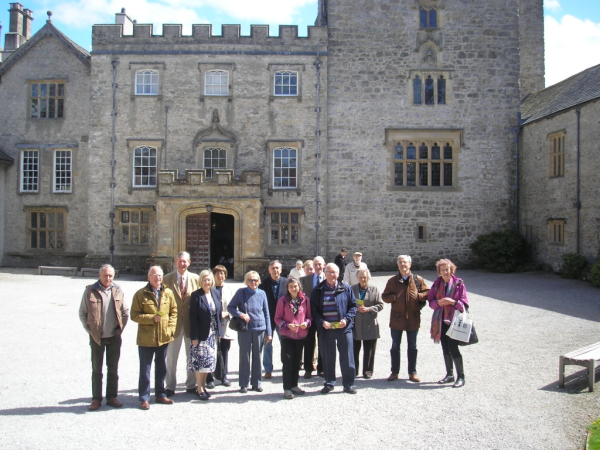We were welcomed in the forecourt of Sizergh Castle by the House Steward who gave us an excellent history of the Strickland family who have lived at Sizergh since at least the thirteenth century. He explained that the castle had begun as a pele tower, was enlarged with three new wings in the 1560s and only altered infrequently later. The family had been staunch Catholics and went into exile with James II only returning in the mid 18th century. This accounted for large numbers of royal Stuart portraits and other memorials. From here we were able to roam through the house at will.

Entering the Great Hall, under a fine Elizabethan screen removed from the floor above, we first encountered two plain chests with carved scrolled escutcheons framing metal locks dated 1571, introducing us to the time of Alice Strickland who with her husband Sir Walter (d 1569) were responsible for most of the exceptional panelling and elaborately carved overmantels which are such a feature of the house and clearly comparable to those at Levens. There was some speculation as to the origins of this tradition in Westmoreland. Anthony Wells – Cole has suggested that at least two are derived from prints by Benedetto Battini, published in Antwerp in the 1550s. A series of remarkable stools on the second floor of the pele tower are also dated 1562 with the initials WS – these have elaborately carved aprons with scrolls and strapwork reminiscent of Netherlandish pattern books. They are surely some of the most remarkable furniture still surviving in the original 16th century house for which they were made. The famous Inlaid Room at the summit of the tower with the bed and internal porch or draught-excluder make it a remarkable ensemble. There was a suggestion that its authorship could be the same foreign craftsmen who worked in the Great Chamber at Gilling Castle near Helmsley dated 1585, where the glass is signed by the German ‘architect’ Bernard Dinninghof’.
A certain prosperity returned to Sizergh in the mid 18th century and is evoked by an early Romney portrait of the scholarly Walter Strickland SJ in a banyan seated in his library surrounded by books, telescopes and the impedimenta of learning. Furniture from his period included early pieces by Gillows for which Susan Stuart was able to identify a chest of drawers cum writing table, and, for his brother, a fine pair of matching tallboys with fluted chamfered sides and blind fretwork friezes. Both are datable to the late 1750s, as was the long suite of mahogany sofas and side chairs, with distinctive ‘camel’ backs and double scrolled fluted arms and cabriole legs with flanking scrolls. Here is one of the elusive early homes of Gillows furniture, so close to Lancaster, and being made for co-religionists.
We are enormously grateful to Adam Bowett and Susan Stuart for sharing their expertise with us on this memorable early summer visit to two exceptionally interesting houses and collections.
